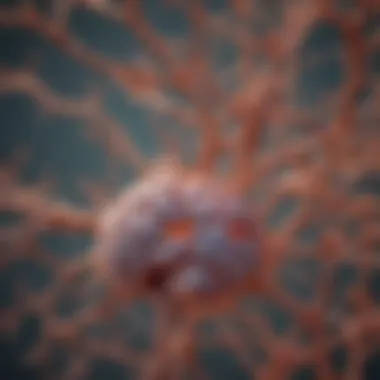Preventing Amyloid Plaques: Strategies and Insights


Intro
Amyloid plaques are often considered the canaries in the coal mine of neurodegenerative diseases, notably Alzheimer’s. These sticky deposits made primarily of amyloid-beta protein aggregate in the brain, leading to detrimental effects on neuronal function. Understanding how to prevent their formation is pivotal for anyone interested in neuroscience, geriatrics, or general healthcare.
Those who have encountered patients with Alzheimer’s or know someone affected by it can appreciate the urgency of this topic. The phenomenon of plaque accumulation is not just a biological curiosity; it drastically impacts the lives of millions. Thus, the quest to find effective strategies to halt or even reverse the process of amyloid plaque formation has become a major focus within the research community.
The significance of this endeavor cannot be overstated. Effective preventive measures could enhance the quality of life for older adults, reducing both the emotional and financial strain on families and health systems. With aging populations globally, exploring these strategies has become an urgent priority, inviting researchers and professionals alike to dissect existing knowledge and seek innovative solutions.
This article aims to delve deep into the mechanisms behind amyloid plaque formation, presenting an overview of the surrounding biochemical, genetic, and environmental factors. Along the way, it will spotlight lifestyle choices and cutting-edge therapies that could potentially curb the progression of amyloid pathology.
Let's embark on this journey by first setting the stage with a thorough exploration of the research background.
Understanding Amyloid Plaques
Amyloid plaques have become a significant focal point in the study of neurodegenerative diseases, notably Alzheimer’s. Their role in the pathophysiology of these conditions cannot be overstated. Understanding these plaques not only sheds light on their formation, but also helps unravel the complexity of neurodegenerative processes. This section aims to unpack essential elements related to amyloid plaques, providing crucial insights into their definition, composition, role in diseases, and the biological mechanisms underpinning their formation.
Definition and Composition
In simple terms, amyloid plaques are abnormal aggregates of proteins that develop in the brain. These plaques primarily consist of beta-amyloid peptides, which are products of the amyloid precursor protein. Over time, these peptides accumulate and form fibrils that cluster together, creating what researchers refer to as amyloid-beta plaques.
- Beta-Amyloid Peptides: These are short chains of amino acids. When they misfold, instead of dissolving, they clump together, forming plaques.
- Composition: Apart from beta-amyloid proteins, plaques may also contain other proteins and cellular debris, which can contribute to neuroinflammation and neuronal death.
Understanding their composition is crucial because it paves the way for potential treatments that target either the formation or clearance of these plaques.
Role in Neurodegenerative Diseases
The presence of amyloid plaques is a hallmark of Alzheimer’s disease, but their role extends beyond mere presence. Research suggests that their accumulation can disrupt cell communication and induce inflammatory responses, which may ultimately lead to neuronal death. In addition to Alzheimer’s, amyloid plaques are now being studied in conditions such as Down syndrome and systemic amyloidosis.
Having a grasp of their role in these diseases opens avenues for prevention strategies. Knowledge of how plaques interact with neurons and other brain cells can inform targeted interventions to mitigate their deleterious effects.
Biological Mechanisms of Formation
The formation of amyloid plaques is a complex biological process. It involves multiple steps, including the cleavage of amyloid precursor proteins and the subsequent aggregation of beta-amyloid peptides. In a nutshell:
- Amyloid Precursor Protein (APP) Processing: APP is cleaved by enzymes, generating beta-amyloid.
- Aggregation: In normal individuals, beta-amyloid is cleared efficiently. However, in those susceptible to plaque formation, the balance tilts.
- Environmental Triggers: Factors such as oxidative stress and inflammation can accelerate this aggregation process.
In understanding these mechanisms, researchers can identify potential therapeutic targets. For instance, drugs might be designed to alter APP processing or enhance beta-amyloid clearance from the brain.
The complexity of amyloid plaque formation emphasizes the need for multifactorial approaches that consider genetic, environmental, and lifestyle influences.
By delving into the nature and role of amyloid plaques, one gains a deeper understanding of their implications. This understanding is pivotal as it lays a foundation for the exploration of effective prevention strategies that can potentially alter the course of neurodegenerative diseases.
Factors Contributing to Amyloid Plaque Accumulation
Understanding what drives amyloid plaque accumulation is crucial as it lays the groundwork for devising effective preventive strategies. Several factors interplay in this complex process, with implications for individual susceptibility to neurodegenerative diseases. Knowing these factors—ranging from genetics to lifestyle choices—equips researchers and health professionals with insights that can lead to meaningful interventions. By addressing these elements, we unlock potential pathways to mitigate plaque formation and improve cognitive health outcomes.
Genetic Predispositions
Genetic predispositions can significantly impact an individual’s risk of developing amyloid plaques. Specific genes play pivotal roles in the body’s ability to manage the production and clearance of amyloid-beta peptides, which are the building blocks of these plaques. The APOE gene, particularly the APOE4 allele, has gained notoriety for its strong association with Alzheimer’s disease. Individuals carrying this allele face a heightened risk for amyloid plaque buildup, leading to a higher likelihood of developing symptoms of dementia.
In the grand tapestry of genetic influence, it is not solely the presence or absence of certain genes that matters, but also how these genetic factors interact with environmental and lifestyle elements. For instance, individuals with genetic vulnerabilities might find themselves at increased risk if their lifestyle choices or environments exacerbate these genetic tendencies. This intricate dance of genetics and environment underscores the need for preventive strategies that take into account one’s genetic background, enhancing the personalization of treatment and preventive regimens.
Environmental Influences


The environment we inhabit is another piece of the puzzle when it comes to amyloid plaque accumulation. Factors such as air pollution, exposure to heavy metals, and even dietary components can all contribute to the brain’s chemical milieu. For example, studies have shown that long-term exposure to fine particulate matter can induce neuroinflammation, a catalyst for amyloid plaque formation. Moreover, harmful environmental substances often interact with biological systems in ways that can lead to oxidative stress, which is known to influence plaque development.
Housing conditions, urban versus rural settings, and lifestyle practices—such as smoking habits—also play their parts in this narrative. Pollution levels tend to be higher in urban areas, potentially contributing to increased risk among city dwellers. This highlights the importance of advocating for cleaner environments as a public health approach to bio-chemically enhance brain health. While we can't instantly change our genetics, we certainly can influence our environmental exposures.
Lifestyle Factors
Lifestyle choices present an additional layer of complexity in amyloid plaque accumulation. Emerging research highlights how diet, exercise, and cognitive engagement can serve as protective factors against cognitive decline. For instance, diets rich in omega-3 fatty acids, such as those derived from fish like salmon, have been linked to decreased risk for dementia—possibly due to their anti-inflammatory properties that keep cortisol levels in check. Incorporating anti-inflammatory foods could be a simple yet effective strategy to mitigate risks.
On the physical activity front, regular exercise appears to bolster brain health significantly. Research suggests that aerobic exercises, especially, increase blood flow to the brain, enhance neurogenesis, and improve overall cognitive performance. Likewise, engaging in mentally stimulating activities—like learning new skills or languages—can fortify the brain's resilience against amyloid plaque accumulation and overall cognitive decline.
In summation, addressing the factors contributing to amyloid plaque accumulation transcends single approaches. By understanding the interplay between genetic, environmental, and lifestyle elements, we can establish a more robust framework for preventing cognitive decline. As we delve further into preventive strategies, these foundational insights will guide tailored interventions that align with individual risk profiles.
Preventive Strategies for Amyloid Plaque Formation
The threat of amyloid plaques looms large in the realm of neurodegenerative diseases, particularly Alzheimer’s. These plaques have become synonymous with cognitive decline, instilling fear in many as they contemplate their own mental health. Thus, strategies aimed at preventing their formation are of paramount significance. Adopting a proactive stance can potentially alter the course of dementia-related diseases, making this discussion crucial for students, researchers, and health professionals alike.
Preventive strategies generally fall into three categories: dietary interventions, physical activity, and cognitive engagement. Each implicates a complex interplay between lifestyle choices and biological processes, shedding light on how seemingly minor changes can yield significant benefits. Understanding these methods is akin to unearthing gems buried beneath the surface of our daily habits.
Dietary Interventions
Diet plays a fundamental role in shaping one’s health, particularly as it pertains to brain function. By focusing on specific dietary interventions, individuals can harness the power of nutrition to stave off amyloid plaque accumulation.
Anti-inflammatory Foods
When we talk about anti-inflammatory foods, we’re essentially referring to those culinary choices that help mitigate chronic inflammation within the body. These foods—like leafy greens, nuts, and fatty fish—are celebrated for their ability to enhance brain health. Incorporating them into one’s diet is a sound strategy, not merely due to their nutritional value but also their overall effects on cognitive function.
The uniqueness of anti-inflammatory foods lies in their capacity to tamp down on the inflammation that can contribute to plaque buildup in the first place. Consistently consuming such foods may lead to quite a remarkable improvement in long-term brain health.
Omega-3 Fatty Acids
Omega-3 fatty acids have garnered attention due to their camouflage in the world of healthy fats. Found in fish like salmon and in flaxseeds, these acids are vital for brain health. Their contribution to preventing amyloid plaque formation cannot be overstated. These fatty acids appear to play a role in reducing neuroinflammation and improving communication between brain cells.
Notably, the standout characteristic of omega-3s is their rich supply of docosahexaenoic acid (DHA), which is essential for maintaining the structural integrity of neuronal membranes. Their inclusion in a balanced diet seems a strategic choice for many looking to preserve cognitive function.
Antioxidant-Rich Diet
Antioxidants are often touted as the superheroes of nutrition, neutralizing free radicals that damage cells. A diet rich in antioxidants typically includes berries, dark chocolate, and beans. These foods contribute significantly to brain health by providing enhanced protection against oxidative stress, one of the culprits in amyloid plaque formation.
The uniqueness of an antioxidant-rich diet lies in its proactive approach to combating cellular damage before it starts. While the advantages are evident, the potential disadvantages are mostly tethered to one's dietary choices and accessibility to such foods.
Physical Activity and Exercise
The adage "move it or lose it" applies astonishingly well to brain health. Regular physical activity is not just a recommendation; it’s an imperative. Integrating exercise into one’s daily life is a powerful preventive measure against amyloid plaque formation.
Types of Beneficial Exercises
A variety of exercises can yield cognitive benefits, ranging from aerobics to strength training. Aerobic activities, such as brisk walking or cycling, increase blood flow to the brain and encourage the release of neurotrophic factors that foster neurons.
Interestingly, this underscores a key characteristic: the multifaceted benefits of physical exercise extend well beyond mere caloric expenditure. The brain is incredibly responsive to physical activity, making it a pivotal choice for retaining cognitive health.
Frequency and Duration
Regularity is king when it comes to exercise. The current consensus suggests aiming for at least 150 minutes of moderate aerobic activity per week. This structured approach not only strengthens the body but also significantly impacts cognitive resilience.


The beauty of frequency and duration is rooted in habit-forming behaviors. The more one engages in physical activity, the more natural it becomes, leading to sustained benefits over time.
Cognitive Engagement
Like a muscle, the brain requires constant exercise to stay fit. Cognitive engagement through learning and various activities is fundamental in combating amyloid plaque formation.
Importance of Lifelong Learning
Lifelong learning stands out as a pillar supporting cognitive health. Engaging in new skills or complex problem-solving can create cognitive reserve, making the brain more resistant to degeneration. Rather than viewing the brain as static, recognizing its ability to adapt fosters a more dynamic view of cognitive wellness.
This notion of lifelong learning emphasizes the adaptability of the brain, highlighting why it’s an invaluable strategy in the fight against the accumulation of amyloid plaques.
Brain-Training Activities
Brain-training activities, often marketed as games, provide a unique avenue for mental stimulation. Activities like puzzles, strategic games, or even language learning can sharpen cognitive functions, potentially staving off cognitive decline.
The key feature here is the diversity of approaches—whether through digital platforms or traditional methods, there’s an option suitable for everyone. However, caution is warranted; not all brain-training apps are created equal, and it’s essential to choose credible options that genuinely challenge the mind.
Epilogue of Section
In sum, the preventive strategies for amyloid plaque formation are multifaceted and interlinked. Each aspect—from dietary choices to physical and cognitive engagement—contributes significantly to maintaining brain health. These choices often require a commitment to lifestyle changes, but the potential for enhancing one’s quality of life is a worthy reward, encouraging a more profound dedication to prevention.
Pharmacological Approaches
The importance of pharmacological approaches in the prevention of amyloid plaques cannot be overstated. These strategies are crucial because they offer targeted methods to combat the molecular underpinnings of neurodegenerative diseases, particularly Alzheimer's. By effectively reducing or preventing the formation of amyloid plaques, these approaches aim not only at addressing the symptoms but potentially altering the disease's progression itself. With the rise of advanced medications and therapies, the landscape of treating neurodegenerative conditions is rapidly evolving.
Current Medications and Their Mechanisms
Current medications designed to target amyloid plaque formation primarily focus on inhibiting the production of amyloid-beta peptide or enhancing its clearance from the brain. One prominent class involves the use of acetylcholinesterase inhibitors, like donepezil and rivastigmine, which do not directly prevent plaque formation but can modestly improve cognitive function in patients. Additionally, drugs like memantine act on the glutamatergic system, potentially providing neuroprotection against excitotoxicity, a concept tied indirectly to amyloid accumulation.
These medications represent a foundational step in managing amyloid plaques. However, they often come with a range of side effects, from gastrointestinal disturbances to neurological impacts, which necessitates careful monitoring.
Emerging Therapeutics
Monoclonal Antibodies
Monoclonal antibodies represent an exciting avenue in the fight against amyloid plaques. These highly specific proteins are designed to bind to amyloid-beta aggregates, allowing the immune system to target and remove them more effectively. A notable example is aducanumab, which has gained attention for its potential to reduce plaque levels in the brains of Alzheimer’s patients. The key characteristic of monoclonal antibodies lies in their specificity; they can home in on amyloid-beta, leaving healthy tissue largely untouched.
One unique feature is their potential to elicit an immune response, which could enhance clearance mechanisms for existing plaques. However, they also come with drawbacks, including a risk of further inflammation or complications in certain patients, which raises questions about their long-term safety and efficacy in treatment protocols.
Gene Therapy
Gene therapy emerges as another promising therapeutic strategy against amyloid plaque formation. This approach aims to correct or modify genes associated with amyloid production and clearance. By using vectors to deliver genetic material that can produce proteins facilitating the breakdown of amyloid-beta, researchers hope to alter the disease trajectory fundamentally. The key characteristic of gene therapy is its potential for long-lasting effects, as opposed to the temporary relief provided by traditional medications.
A unique feature of gene therapy is the possibility of tailoring interventions based on individual genetic profiles, which can enhance the treatment's effectiveness. However, challenges remain, such as delivery strategies to the brain and concerns surrounding off-target effects, which warrant further exploration and clinical trials.
"Pharmacological approaches, particularly using monoclonal antibodies and gene therapy, symbolize a leap towards personalized medicine in the context of amyloid plaque management."
Assessment and Monitoring Techniques
In the field of amyloid plaque research, assessment and monitoring techniques are critical. These approaches allow for early identification and tracking of amyloid accumulation, which is vital in making informed decisions about prevention and treatment strategies. Regular assessments can help gauge the effectiveness of interventions—whether dietary, lifestyle-related, or pharmacological—by providing a clearer picture of neurodegenerative changes taking place in the brain.
Moreover, knowledge of how plaques develop offers invaluable insights into potential targets for therapeutic measures. Assessing amyloid plaques enhances our understanding of the disease, empowering researchers and clinicians to adjust treatment protocols based on individual patient needs.


Imaging Techniques
Imaging plays a substantial role when it comes to monitoring progression in conditions like Alzheimer’s disease. Two imaging modalities stand out: PET scans and MRI innovations.
PET Scans
Positron Emission Tomography (PET) scans represent a prominent tool in visualizing amyloid plaques. PET scans utilize radioactive tracers that bind specifically to amyloid proteins in the brain, allowing for an indirect measure of plaque burden. This characteristic makes it a valuable method for quantifying and monitoring amyloid levels over time. One of the major benefits of PET scans is their ability to detect plaque formations even in the early stages of neurodegeneration, long before symptoms manifest.
However, the relatively high cost of PET scans and the need for specialized equipment can limit their accessibility. Furthermore, the interpretation of PET images requires medical expertise, making it less straightforward for routine assessments by general practitioners.
"The precision of PET imaging underscores its role in advancing our understanding of neurodegenerative diseases."
MRI Innovations
Magnetic Resonance Imaging (MRI) represents another innovative approach to the assessment of amyloid plaques, particularly through advanced techniques that provide detailed images of brain structures. With innovations in functional MRI, it's possible to observe brain activity in relation to amyloid presence, further linking structural changes to cognitive function. This method is non-invasive and doesn’t involve ionizing radiation, making it a safer alternative for frequent monitoring.
The unique feature of MRI innovations lies in their ability to showcase not only plaque distribution but also changes in brain volume over time, which correlates with degeneration. On the downside, standard MRI cannot differentiate between amyloid plaques and other forms of protein aggregations, which may confuse the interpretation. Nonetheless, MRI remains popular for its versatility and risk-free nature, positioning it as a leading choice among clinicians.
Biomarkers and Diagnostics
When it comes to diagnosing and monitoring the progression of amyloid plaques, biomarkers hold significant promise. Biomarkers are measurable indicators of the severity or presence of some disease state, and in the case of amyloid accumulation, they can play a pivotal role in identifying at-risk individuals.
Reliable biomarkers could come from various sources, including cerebrospinal fluid (CSF), blood, or even through neuroimaging distinctives. For instance, specific proteins associated with amyloid plaques can be isolated in CSF samples, providing clear indications of plaque levels in the brain. While emerging research is investigating blood-based biomarkers as a more accessible alternative, none have yet achieved the specificity required for wide clinical application.
Overall, monitoring biomarker levels in conjunction with imaging techniques could form the backbone of comprehensive strategies aimed at preventing the progression of neurodegenerative disorders. As research advances, these tools will likely become indispensable for both diagnosis and the tailoring of therapeutic interventions.
Future Directions in Amyloid Plaque Research
Understanding the future of amyloid plaque research is crucial as we strive to combat neurodegenerative diseases. With each passing year, scientific communities are unveiling new avenues in research that hold promise for better prevention and treatment strategies. This exploration is not just scientifically rich but also has direct implications for millions of individuals at risk of conditions like Alzheimer’s disease.
Innovative research approaches can lead to discovering potentially powerful interventions. As we look ahead, it is essential to focus on strengthening existing methodologies while integrating new technologies in our toolbox. This ongoing investigation promises to bridge gaps in our current understanding and treatment of amyloid plaque formation.
Novel Research Approaches
Recent advancements in neurobiology suggest that researchers are increasingly leveraging interdisciplinary methods. These novel approaches encompass a range of fields, from genetics to nanotechnology. By harnessing such diverse perspectives, scientists can examine amyloid plaques in ways we haven't previously imagined.
- Advanced Imaging Techniques: The use of high-resolution imaging allows for real-time monitoring of amyloid plaque development within the brain. Techniques such as in vivo imaging not only enhance our knowledge but also provide immediate feedback on potential interventions.
- Big Data Analytics: As datasets grow, employing machine learning tools enables researchers to analyze patterns and predict outcomes more effectively. This influx of data helps in identifying potential risks and developing personalized prevention strategies more efficiently.
- 3D Cellular Models: Creating intricate models that mimic the human brain opens doors to novel testing grounds for potential treatments. Through these 3D models, scientists can study plaque interactions in a highly controlled environment, leading to groundbreaking discoveries.
The convergence of such methods provides a comprehensive tapestry of insights into amyloid plaque dynamics, paving the way for innovative therapeutic strategies.
Investigating Genetic Contributions
Genetics play a pivotal role in the formation of amyloid plaques, and recent research is honing in on this aspect with renewed vigor. By elucidating the genetic underpinnings that predispose individuals to plaque accumulation, we can tailor interventions more effectively.
The following areas are critical in this exploration:
- Genome-Wide Association Studies (GWAS): These studies help to identify specific genetic variants linked to amyloid plaque formation. Understanding these associations allows researchers to distinguish between genetic and environmental risk factors.
- CRISPR and Gene Editing: The application of gene-editing technologies like CRISPR opens new vistas in the field. By potentially altering genetic predispositions linked to amyloid plaque formation, scientists could mitigate risks before they escalate into severe neurodegenerative conditions.
- Family Studies: Investigating hereditary patterns in families with a history of Alzheimer’s offers deep insight into genetic factors. Such studies can guide research into protective factors that may arise in those with a genetic predisposition but who remain symptom-free.
End
Reflecting on the myriad ways to prevent amyloid plaque formation, it becomes evident that understanding the implications of our lifestyle choices is essential. This article has meticulously unraveled various strategies, emphasizing not just pharmacological solutions but also, crucially, the role of diet, exercise, and cognitive engagement.
Engaging in regular physical activity, for instance, isn’t merely beneficial for maintaining overall health; it can potentially reduce the risk of amyloid accumulation in the brain. Studies have pointed out that different types of exercises have distinctive effects on cognitive function. Exercising regularly is like giving the brain a booster shot, enhancing both circulation and neuroplasticity, which may keep amyloid at bay.
On the dietary front, integrating omega-3 fatty acids into one’s meals is particularly potent. Foods rich in antioxidants and anti-inflammatory properties play a huge role in fending off oxidative stress, which is often seen as a driving factor for plaque formation. It’s like having a protective shield that guards the brain from potential harm.
Cognitive engagement should not be overlooked either. Lifelong learning and mentally stimulating activities—like puzzles or reading—are essential. They can create new neural connections, maintaining and potentially boosting cognitive reserve, which may mitigate the impact of amyloid plaques. As the saying goes, "use it or lose it," underlining the importance of continually challenging our brains.
As we look forward, the frontier of amyloid plaque research holds great promise. With ongoing investigations focusing on genetic contributions and novel therapeutic approaches, there is hope that tailored interventions could be developed. The synergy of lifestyle modifications along with emerging treatments could provide a comprehensive shield against the insidious nature of neurodegenerative diseases.
In closing, the strategies for preventing amyloid plaques are multifaceted and require a proactive approach. Understanding and implementing these preventive measures not only helps in maintaining brain health but also enhances quality of life. Each step taken toward making informed choices can play a vital role in steering one’s cognitive future right into a better horizon.







